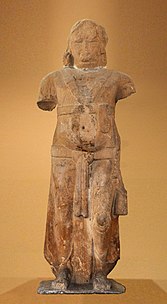Parkham Yaksha
| Parkham Yaksha | |
|---|---|
Front Back | |
| Size | 2.6 meters |
| Writing | Brahmi |
| Created | 150 BCE |
| Discovered | Parkham, Uttar-Pradesh 27°17′14″N 77°43′03″E / 27.287358°N 77.717414°ECoordinates: 27°17′14″N 77°43′03″E / 27.287358°N 77.717414°E |
| Present location | Mathura Museum, Mathura |
| Registration | GMM C.1 |
The Parkham Yaksha is a colossal statue of a Yaksha, discovered in the area of Parkham, in the vicinity of Mathura, 22.5 kilometers south of the city.[1] The statue, which is an important artefact of the Art of Mathura, is now visible in the Mathura Museum. It has been identified as the Yaksha deity Manibhadra, a popular deity in ancient India.
Date[]
The Parkham Yaksha is datable to period 200 BCE – 50 BCE on paleographic and stylistic grounds.[2][3] It has also been dated more precisely by Heinrich Lüders, who gives it a mid-2nd century date, and Sonya Rhie Quintanilla who dates it to circa 150 BCE.[1]
Inscription[]
The statue is 2.6 meters tall, including its base of about 30 centimeters.[1] The badly corroded inscription in early Brahmi script on the top side of the base reads:
 Parkham Yaksha inscription with transliteration, paleographically dated to mid-2nd century BCE.[4]
Parkham Yaksha inscription with transliteration, paleographically dated to mid-2nd century BCE.[4](





